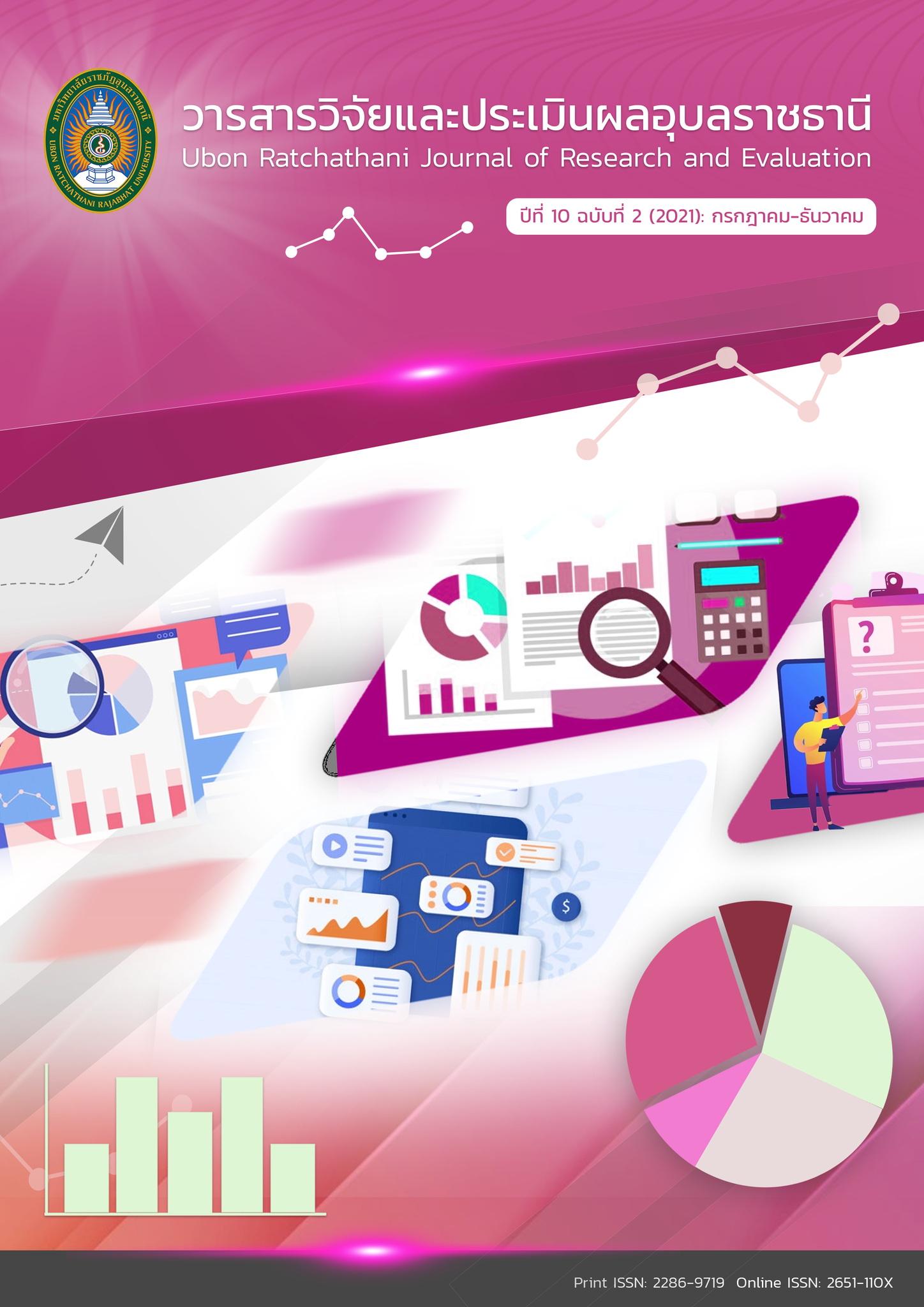The development of learning outcome with STEM Education Sciences and Technology substance group entitled “Materials around us” for Prathomsuksa 2 students
Keywords:
learning plan, learning arrange by using STEM education, creativity, learning outcomeAbstract
This research aims to 1) compare pre- and post-learning outcome of Prathomsuksa 2 students
2) compare creativity pre- and post-learning of Prathomsuksa 2 students 3) study satisfaction of Prathomsuksa 2 students by using science learning plan of STEM education in the topic of Materials around us. The samples that are used in the research are students who are studying in Prathomsuksa 2 in 1st academic year 2020 at Banklang School belong to Primary Educational Service Area Office Ubon Ratchathani area 5, Dech-Udom District, Ubonratchathani for 1 classroom with students 30 persons. The students are from group selecting. The tools used to gather information consists of 1) science learning plan of STEM education 2) the test of learning outcome 3) the test of creativity 4) the survey of satisfaction. The statistics used to analyze information are mean, percentage, standard deviation, and
t-test.
References
กระทรวงศึกษาธิการ.(2551). มาตรฐานการเรียนรู้และตัวชี้วัด กลุ่มสาระการเรียนรู้วิทยาศาสตร์ (ฉบับปรับปรุง
พ.ศ. 2560). ตามหลักสูตรแกนกลางการศึกษาขั้นพื้นฐาน พุทธศักราช 2551.
Ministry of Education. (2551) The Basic Education Core Curriculum B.E. 2551 Bangkok. Teachers
Council of Thailand Printing House Ladprao.[in Thai]
Ministry of Education. (2551). learning standards and indicators Sciences substance group (Revised
edition B.E.2560). By The Basic Education Core Curriculum B.E. 2551. [in Thai]
ฉัตรชัย เครืออินทร.(2557). รูปแบบการจัดกิจกรรมการเรียนรูวิชาวิทยาศาสตร เรื่องวัสดุและสมบัติของวัสดุ แบบสะเต็ม
ศึกษา (STEM education) ของนักเรียนชั้นประถมศึกษาปที่ 5. รายงานผลการประชุมวิชาการ ระดับชาติ
“ศึกษาศาสตรวิจัย” ครั้งที่ 1 คณะศึกษาศาสตร มหาวิทยาลัยสงขลานครินทร์ วิทยาเขตปัตตานี วันที่ 29-
30 พฤษภาคม 2557. โรงแรมหรรษา เจบี อำเภอหาดใหญ่ จังหวัดสงขลา.
Kruein, C. (2014). The format of learning activities for science subjects Material and properties of
material STEM education of Prathom Suksa 5 students. Proceeding of the 1st National
Academic Research Conference, Faculty of Education, Prince of Songkla University, Pattani
Campus, 29-30 May 2014. Hansa JB Am Hotel, Hat Yai District, Songkhla Province. [in Thai].
มนตรี จุฬาวัฒนทล.(2557). การศึกษาวิทยาศาสตร์ เทคโนโลยี วิศวกรรมและคณิตศาสตร์ หรือ“สะเต็ม”. สมาคมครู
วิทยาศาสตร์ คณิตศาสตร์และเทคโนโลยีแห่งประเทศไทย, 19 (มกราคม-ธันวาคม), 2556.
Chulawatthanatol M.(2557). Science education Technology Engineering and Mathematics or “Stem”.
Teacher's Association for Science Engineering and Mathematics of Thailand,19 (January-December), 2556. [in Thai]
รักษพล ธนานุวงศ์.(2557). กิจกรรมรถไฟเหาะ บูรณาการความรู้ด้านวิทยาศาสตร์ คณิตศาสตร์ และเทคโนโลยีตามแนวคิด
สะเต็มศึกษา ส่งเสริมการเรียนรู้ด้านการคมนาคมขนส่งทางราง. สถาบันส่งเสริมการสอนวิทยาศาสตร์และ
เทคโนโลยี, 42(185),38-41.
Thananuwong R.(2557). Roller coaster activity integrate scientific knowledge Mathematics and Technology
conceptual of STEM education. Promote learning on rail transportation. Institute for the Promotion of Teaching Science and technology. 42(185),38-41. [in Thai]
วรรณา รุ่งลักษมีศรี.(2551). ผลของการเรียนการสอนที่เน้นกระบวนการออกแบบทางวิศวกรรมที่มีต่อความสามารถใน
การแก้ปัญหาเชิงวิทยาศาสตร์ และทักษะกระบวนการทางวิทยาศาสตร์ขั้นผสมผสานของนักเรียน
มัธยมศึกษาตอนต้น ในโรงเรียนสาธิต. กรุงเทพฯ : จุฬาลงกรณ์มหาวิทยาลัย.
RungLakshmi, W. (2008). Effects of instruction emphasizing engineering design process on scientific
problem solving ability and integrated science process skills of lower secondary school
students in demonstration schools (Master of education thesis, program in Science
Education). Chulalongkorn University, Bangkok. [in Thai].
วศิณีส์ อิศรเสนา ณ อยุธยา.(2560). เรื่องน่ารู้เกี่ยวกับ STEM Education (สะเต็มศึกษา). กรุงเทพฯ: จุฬาลงกรณ์
มหาวิทยาลัย.
Israsena Na Ayutthaya W.(2560). Things to know about STEM Education (Stem education). Bankok:
Chulalongkorn University. [in Thai]
อมรรัตน์ จำปาวัตตะ.(2562) การพัฒนาความคิดสร้างสรรค์ของนักเรียนชั้นประถมศึกษาปีที่ 3 เรื่องวัสดุและวัตถุ
โดยการจัดการเรียนรู้แบบสะเต็มศึกษา. วิทยานิพนธ์ครุศาสตรมหาบัณฑิต สาขาวิชาการสอน
วิทยาศาสตร์ มหาวิทยาลัยราชภัฏสกลนคร.
Jumpawatta A. (2562) The Development of Creative Thinking for Prathomsuksa 3 students on the Topic of
Materials and Objects Using the Learning Management Based on STEM Education thesis for the
master of Education Degree in Science Teaching Sakon Nakhon Rajabhat University. [in Thai]
อุไร ดอกคำ.(2562). การพัฒนาชุดกิจกรรมการเรียนรู้วิทยาศาสตร์ ตามแนวสะเต็มศึกษา (STEM Education)
เรื่อง ดินในท้องงถิ่นของเรา เพื่อส่งเสริมความสามารถในการคิดแก้ปัญหา สำหรับนักเรียนชั้น
ประถมศึกษาปีที่ 2 วิทยานิพนธ์ครุศาสตรมหาบัณฑิต สาขาการพัฒนาหลักสูตรและการเรียนการสอน
มหาวิทยาลัยราชภัฏอุบลราชธานี.
Dokcom U.(2562). The Development of science learning activities by STEM Education of Our Local Soil to
Promote the Ability to Solve Problems for Prathomsuksa 2 students thesis for Course
development and teaching and learning Ubon Ratchathani Rajabhat University. [in Thai]
Han, S.,Capraro,R.,& Capraro, M.M. How science, technology, engineering, andmathematics
(STEM) project-based learning (PBL) affects high, middle, and low achievers
differently: The impact of student factors on achievement. International Journal of
Science and Mathematics Education. 13(5): 1089-1113, 2014.
National Research Council.(2011). Knowing what students know: The science and design of
educational assessment. Committee on the Foundations of Assessment. J. Pellegrino, N.
Published
How to Cite
Issue
Section
License
1. บทความที่ตีพิมพ์ในวารสารนี้ได้มีการตรวจสอบการลอกเลียนงานวรรณกรรมแล้ว ไม่เกินร้อยละ 25
2. บทความที่ตีพิมพ์ในวารสารนี้เป็นข้อคิดเห็น ข้อค้นพบของผู้เขียนบทความ โดยผู้เขียนบทความต้องเป็นผู้รับผิดชอบต่อผลทางกฎหมายใด ๆ ที่อาจเกิดขึ้นจากบทความนั้น ๆ
3. บทความ ข้อมูล เนื้อหา รูปภาพ ฯลฯ ที่ได้รับการตีพิมพ์ในวารสารวิจัยและประเมินผลอุบลราชธานี ถือเป็นลิขสิทธิ์ของวารสารวิจัยและประเมินผลอุบลราชธานี หากบุคคลหรือหน่วยงานใดต้องการนำทั้งหมดไปเผยแพร่ต่อหรือเพื่อกระทำการใดๆ จะต้องได้รับอนุญาตเป็นลายลักษณ์อักษรจากวารสารวิจัยและประเมินผลอุบลราชธานีก่อนเท่านั้น และจะต้องมีการอ้างอิงวารสารวิจัยและประเมินผลอุบลราชธานี ฉบับนั้น ๆ ด้วย






